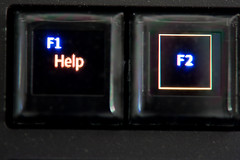Sunday, May 18, 2008
The D3 arrived. Part III: Software, DXO sucks
Before I bought my Nikon D200 I was using ACDSee and Paint Shop Pro for corrections from pictures taken with my point-and-shoot pocket cameras. However I used both pretty rarely only. So when I bought the D200 I asked several of my friends what software to use to do RAW to JPEG conversion. Many of them suggested I have a look at DXO. And in fact DXO is awesome in theory and also—if you can get it to work and happen to own the correct lenses—in practice. Unfortunately it is kind of impossible to use the software. Its user interface is the worst piece of crap I have ever seen until then. I hoped the update to the newest version would make it any better. But guess what, it became even more unstable and useless. Well the results, if you get any, are still awesome, yet kind of impossible to get. Especially with the Nikon D3. It detects the camera and lens and still refuses to do anything with the images. And before you wonder, there is no way whatsoever to make DXO work on Windows 64. They think that they produced such a holy grail of software that copy protection goes over everything. And people like them wonder why their software gets cracked... Enough anyway, DXO is gone.

So I decided on trying the demo software that Nikon ships with the D3. Demo? Yes, that's right. You just got a damn expensive camera and Nikon didn't even bother to give you a piece of software that allows you to make use of the camera's RAW format. But, well, that is no loss because Nikon managed to produce a piece of crap that is impossible to use. Right, Nikon Capture NX comes with a user interface that is indeed worse than DXO—and I thought that would be impossible.
So I tried ACDSee pro and after the update that makes it able to handle newer RAW formats, the batch processor works fast and produces nice color and exposure corrections. Unfortunately, you won't get the nice lens/camera combination fix-up that DXO would provide. All in all, ACDSee is a very nice and fast organizing and viewing software that also allows a wide variety of corrections. And the user interface is pretty nice as well. Well done. Even after about ten years of using ACDSee I still use it. And today I actually use it more than ever before. One thing I use this for is red-eye corrections. The others are the mentioned batch converter and I also like the crop feature. Last but not least, I have always used it for image rotation, a thing ACDSee used to be famous for.
Next step, there must be something that allows for more corrections. So I tried Adobe Lightroom 2.0 beta. And again a nice very easy to use user interface. It also supports importing much more to my likings. So when you connect the camera you get an import dialog that allows to import by date shot. Something I really like: organizing by set. And if there are more sets on a day, then you simply select by picture and import into different folders. The next thing is the browser which is as fast as the one from ACDSee just not so powerful. I chose the importer of Lightroom, which automatically applies some EXIF tagging, to mark all my picture as my pictures—yes, the D3 does not allow this. All I am missing here is lens detection from EXIF information and turning that into tags. For that, I have some perl/php scripts but am usually to lazy to use them. After importing the images you can apply corrections. You can copy corrections applied to one picture to other ones and it actually works. When done with corrections, the images can be converted in a batch processor while the application still works! And if you put more pictures up for conversion, Lightroom simply adds these pictures to the stack of the batch processor. And by the way, Lightroom has a nice black&white conversion.

The third software I use is Paint Shop Pro. Several years ago I started using this software to do pixel corrections or to generate small images for web sites. In the meantime the software specializes more and more as a photography solution. It too has a usable browser and a bunch of filters. I used it, for instance, to cut pictures free—as in, make the background transparent.
My current work flow is as follows. I import images from the camera using Lightroom. I do so by set into a directory. The directory name is the date in YYYYMMDD format followed by a set description. I then use Lightroom to do color and exposure corrections as well as cropping. Alternatively I use ACDSEE to do full automatic conversion to JPEG. Sometimes I do so to speed the process up. In general, I prefer to apply as few corrections as possible. That is, I try to do nice shots in RAW with automatic WB. I select pictures for upload in several ways. First, I sometimes delete already in the camera, then I delete already before conversion to JPEG. Both ACDSee and Lightroom are fast enough to allow for browsing and deletion using only RAW. When ending up with lots of pictures in a set with several being more or less the same, I use the rating support of either software for selection. Once conversion to JPEG is done, I select once more. This time, however, I only delete the JPEGs, keeping the RAW images. The last step is uploading. For this I use Flock's built-in uploader to flickr.

The reason for using flickr is simple. It was working for me prior to anything else by the time my D200 made me constantly run out of space on my own server. Today I would definitively use Panoramio instead. And the reason for that is simple too. It has a very nice integration with maps.google.com (check out the new 'More...' button) and they are way better than Yahoo maps.
Conclusion. ACDSee, Lightroom and PaintShopPro all have a usable user interface, especially the former two. Once Lightroom 2 gets released I will buy it, probably bundled with PhotoShop. I haven't used that in a long time. But the combination sounds like a very good idea. And hopefully it is better than having to switch to something completely different like PaintShopPro. I tried a bunch of uploader tools, but the only one that works for me is Flock.
Final note. DXO in theory is an awesome tool. But it is in fact completely useless crap, it does not work, the support is unbelievable ridiculous incompetent and updates and upgrades seem to make it worse.

So I decided on trying the demo software that Nikon ships with the D3. Demo? Yes, that's right. You just got a damn expensive camera and Nikon didn't even bother to give you a piece of software that allows you to make use of the camera's RAW format. But, well, that is no loss because Nikon managed to produce a piece of crap that is impossible to use. Right, Nikon Capture NX comes with a user interface that is indeed worse than DXO—and I thought that would be impossible.
So I tried ACDSee pro and after the update that makes it able to handle newer RAW formats, the batch processor works fast and produces nice color and exposure corrections. Unfortunately, you won't get the nice lens/camera combination fix-up that DXO would provide. All in all, ACDSee is a very nice and fast organizing and viewing software that also allows a wide variety of corrections. And the user interface is pretty nice as well. Well done. Even after about ten years of using ACDSee I still use it. And today I actually use it more than ever before. One thing I use this for is red-eye corrections. The others are the mentioned batch converter and I also like the crop feature. Last but not least, I have always used it for image rotation, a thing ACDSee used to be famous for.
Next step, there must be something that allows for more corrections. So I tried Adobe Lightroom 2.0 beta. And again a nice very easy to use user interface. It also supports importing much more to my likings. So when you connect the camera you get an import dialog that allows to import by date shot. Something I really like: organizing by set. And if there are more sets on a day, then you simply select by picture and import into different folders. The next thing is the browser which is as fast as the one from ACDSee just not so powerful. I chose the importer of Lightroom, which automatically applies some EXIF tagging, to mark all my picture as my pictures—yes, the D3 does not allow this. All I am missing here is lens detection from EXIF information and turning that into tags. For that, I have some perl/php scripts but am usually to lazy to use them. After importing the images you can apply corrections. You can copy corrections applied to one picture to other ones and it actually works. When done with corrections, the images can be converted in a batch processor while the application still works! And if you put more pictures up for conversion, Lightroom simply adds these pictures to the stack of the batch processor. And by the way, Lightroom has a nice black&white conversion.

The third software I use is Paint Shop Pro. Several years ago I started using this software to do pixel corrections or to generate small images for web sites. In the meantime the software specializes more and more as a photography solution. It too has a usable browser and a bunch of filters. I used it, for instance, to cut pictures free—as in, make the background transparent.
My current work flow is as follows. I import images from the camera using Lightroom. I do so by set into a directory. The directory name is the date in YYYYMMDD format followed by a set description. I then use Lightroom to do color and exposure corrections as well as cropping. Alternatively I use ACDSEE to do full automatic conversion to JPEG. Sometimes I do so to speed the process up. In general, I prefer to apply as few corrections as possible. That is, I try to do nice shots in RAW with automatic WB. I select pictures for upload in several ways. First, I sometimes delete already in the camera, then I delete already before conversion to JPEG. Both ACDSee and Lightroom are fast enough to allow for browsing and deletion using only RAW. When ending up with lots of pictures in a set with several being more or less the same, I use the rating support of either software for selection. Once conversion to JPEG is done, I select once more. This time, however, I only delete the JPEGs, keeping the RAW images. The last step is uploading. For this I use Flock's built-in uploader to flickr.

The reason for using flickr is simple. It was working for me prior to anything else by the time my D200 made me constantly run out of space on my own server. Today I would definitively use Panoramio instead. And the reason for that is simple too. It has a very nice integration with maps.google.com (check out the new 'More...' button) and they are way better than Yahoo maps.
Conclusion. ACDSee, Lightroom and PaintShopPro all have a usable user interface, especially the former two. Once Lightroom 2 gets released I will buy it, probably bundled with PhotoShop. I haven't used that in a long time. But the combination sounds like a very good idea. And hopefully it is better than having to switch to something completely different like PaintShopPro. I tried a bunch of uploader tools, but the only one that works for me is Flock.
Final note. DXO in theory is an awesome tool. But it is in fact completely useless crap, it does not work, the support is unbelievable ridiculous incompetent and updates and upgrades seem to make it worse.
Blogged with the Flock Browser
Labels: Photography
Subscribe to Posts [Atom]
